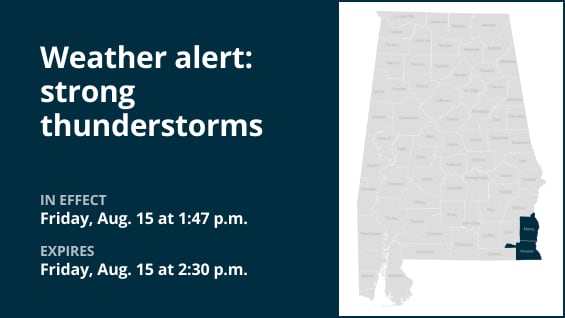At 1:47 p.m. on Friday, the National Weather Service revised its weather notice to include heavy thunderstorms through 2:30 p.m. in Henry and Houston counties.
Residents should anticipate 50 mph wind gusts.
Strong thunderstorms were detected by Doppler radar at 1:46 p.m. along a line that ran from close to Fort Gaines to eight miles north of Columbia to close to Webb. The weather service reports that the movement was east at 20 mph. “Gusty winds could knock down tree limbs and blow around unsecured objects.”
Fort Gaines, Morgan, Blakely, Ashford, Cowarts, Edison, Arlington, Webb, Columbia, Kinsey, Douglasville, Centerville, Avon, Gordon, Damascus, Jakin, Bellville, Haleburg, Bluffton, and Parksville are among the places affected by the alert.
The weather service states that “If outdoors, consider seeking shelter inside a building.”
Preparing for impending lightning strikes: Expert safety recommendations
About 25 million lightning strikes occur in the US annually, primarily in the summer. The weather service estimates that it kills around 20 people a year. As thunderstorms get closer, the risk of lightning increases; it peaks when the storm is directly overhead and then progressively decreases as it passes.
Consider the following advice to keep yourself safe during a thunderstorm:
Plan for lightning safety:
-
When venturing outdoors, it’s crucial to have a lightning safety plan in place.
-
Monitor the sky for threatening signs and listen for the sound of thunder. If thunder is audible, it’s an indication that lightning is nearby.
-
Seek a safe place to shelter, preferably indoors.
Indoor safety precautions:
-
Once you’re indoors, avoid using corded phones, electrical devices, plumbing fixtures, and stay away from windows and doors.
-
These precautions help reduce the risk of electrical surges, as lightning can follow conductive pathways.
Hold off till the all-clear:
-
After the last lightning strike or thunderclap, wait at least 30 minutes before resuming outdoor activities.
-
Lightning can strike even when a storm has seemingly passed, so exercise caution.
When there is no indoor shelter:
Take these precautions to increase your safety if you are outside during a thunderstorm without access to indoor shelter:
-
Avoid open fields, hilltops, or ridge crests, as they expose you to greater lightning risk.
-
Steer clear of tall, isolated trees and other prominent objects. In wooded areas, stay close to lower stands of trees.
-
If you’re in a group, ensure that individuals are spaced out to prevent lightning current from transferring between people.
-
Camping in an open setting during a thunderstorm is strongly discouraged. If you have no alternative, set up camp in a valley, ravine, or other low-lying areas. It’s crucial to note that a tent provides no protection against lightning.
-
Do not approach water bodies, wet objects, or metal items. Although water and metal do not attract lightning, they conduct electricity effectively and can pose significant risks.
In conclusion, readiness and alertness are your greatest allies while dealing with the threat of lightning. You may put your safety first and drastically lower the chance of lightning-related mishaps by adhering to these rules.
Driving through downpours: Safety guidelines for wet roads
If heavy rainfall persists or if runoff is substantial, flooding may result. Saturated soils and/or heavy rainfall can cause excessive runoff. To keep safe during periods of intense rain, heed these weather service recommendations:
Watch out for flooding rivers:
Avoid parking or strolling close to culverts or drainage ditches during periods of intense precipitation, as the swift-moving water can be quite dangerous.
Keep your distances from other vehicles safe:
To keep a safe following distance behind the car in front of you, follow the two-second rule. To account for decreased traction and braking efficiency in heavy weather, give yourself an extra two seconds.
Reduce your speed and exercise caution:
Reduce your speed if it’s raining and the roads are wet. Reduce your speed gently by taking your foot off the accelerator. Never apply the brakes abruptly since this could cause the vehicle to slide.
Pick your lane carefully:
Water tends to pool in the outside lanes, so stick to the central ones.
Visibility is important.
Turn on your headlights to improve visibility in severe rain. Rain-stained windows can hide cars in blind situations, so be cautious.
Be cautious on slick roads:
Roads are slickest during the first half-hour of rain because of a combination of rain, oil, and filth. Be especially careful during this time.
Stay a safe distance away from big cars:
Avoid following buses or big vehicles too closely. Their big tires produce a mist that blurs your eyesight. Additionally, if you have to pass them, proceed with caution.
Be mindful of your wipers:
Visibility may be hampered by overloaded wiper blades. If the rain significantly impairs your vision, stop and wait for the weather to clear up. Seek cover in safe spaces or rest areas.
Position your car as far off the road as you can, preferably beyond guardrails, if stopping by the side of the road is your only choice. To let other cars know where you are, turn on your emergency flashers and keep your headlights on.
Taking these safety measures will significantly improve your road safety while it’s raining a lot. For a safe trip, keep yourself updated on weather conditions and follow local authorities’ instructions.
United Robots offers a service called Advance Local Weather Alerts that gathers the most recent information from the National Weather Service using machine learning.






